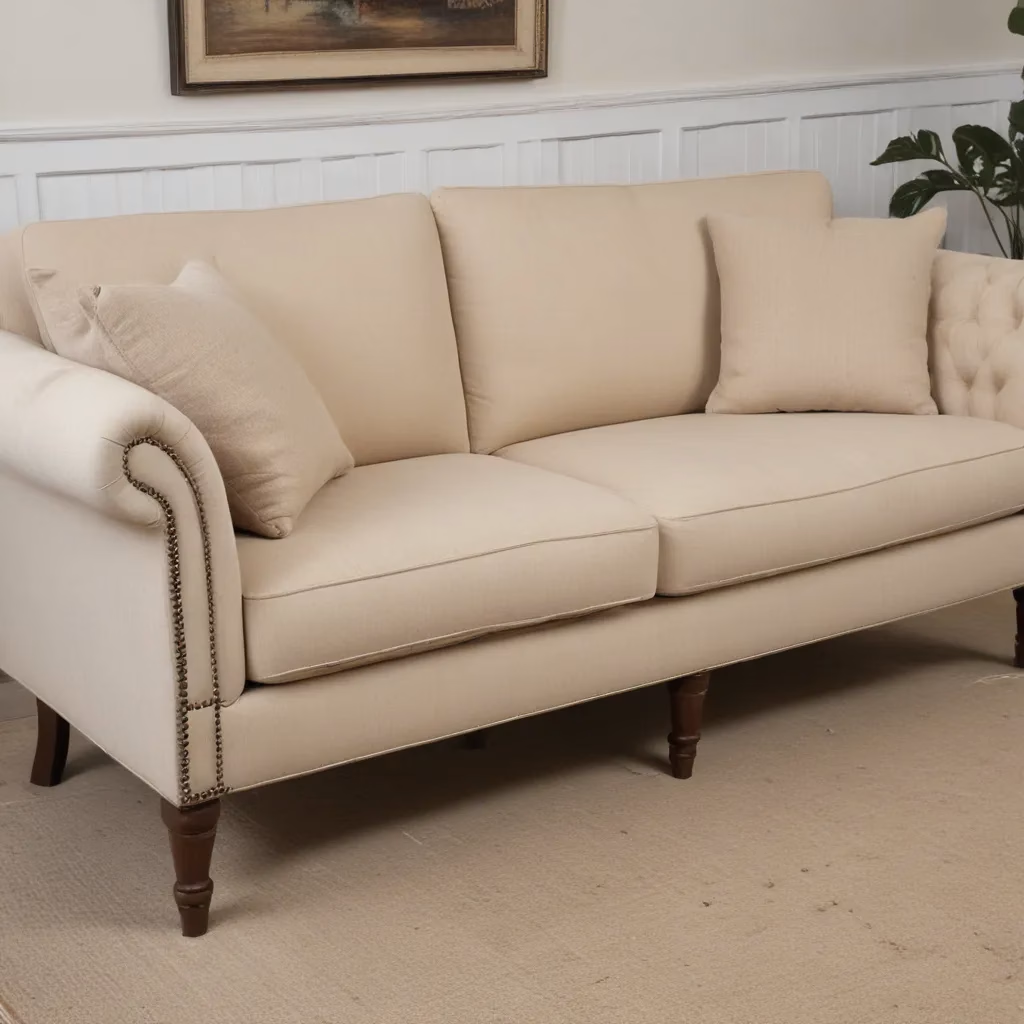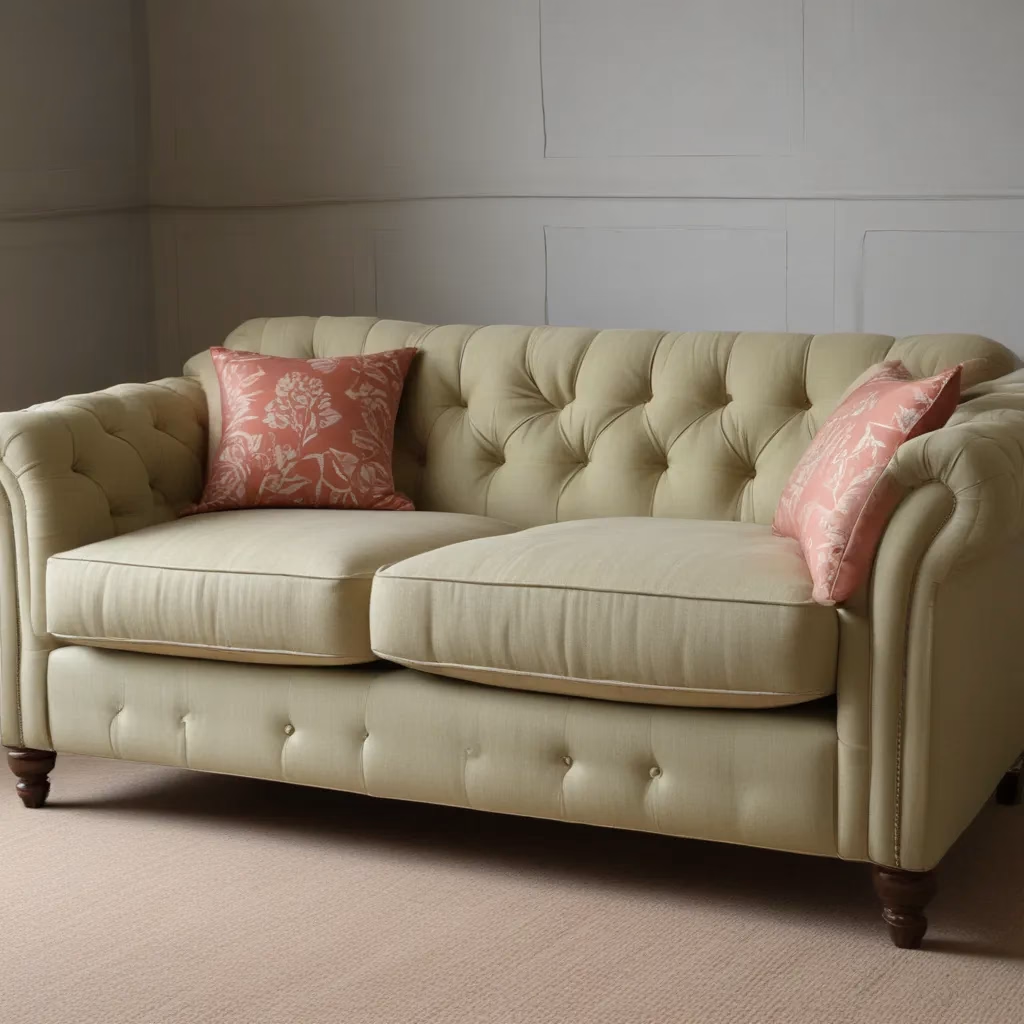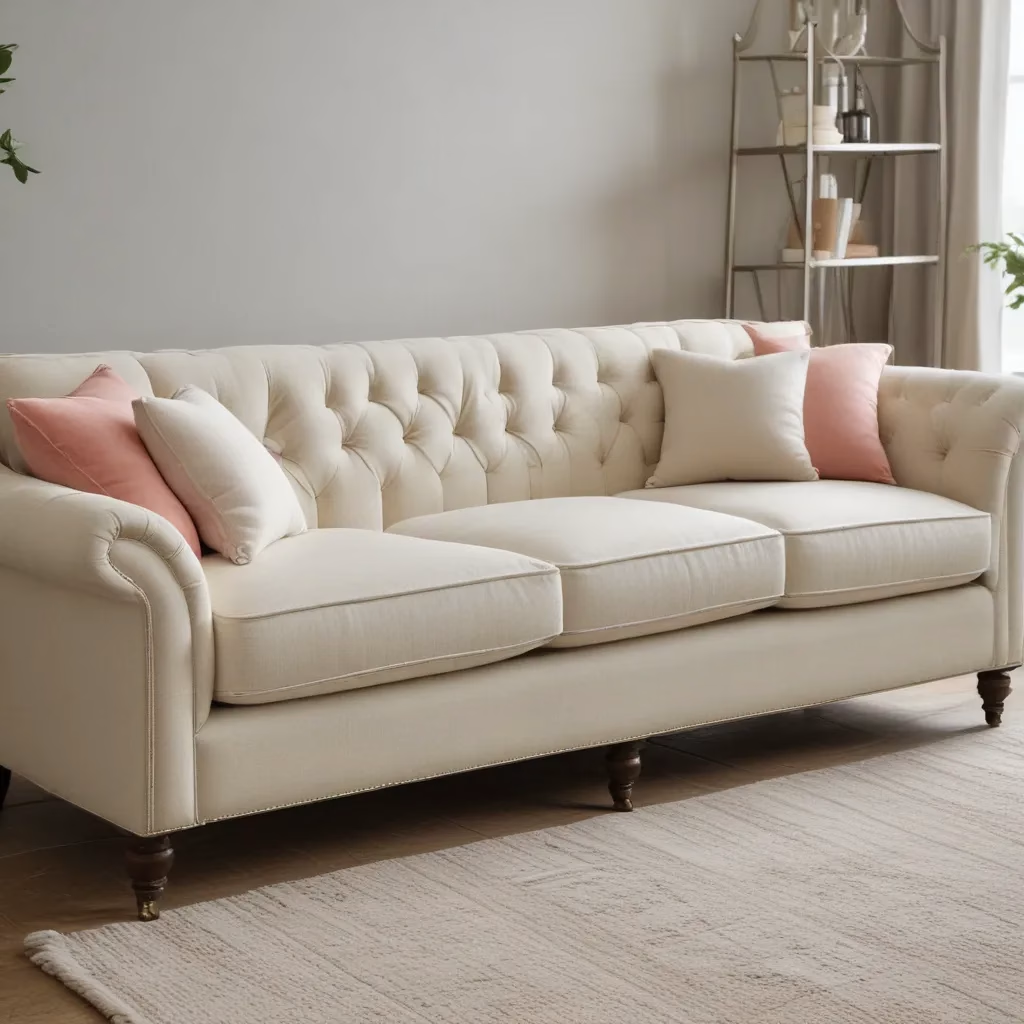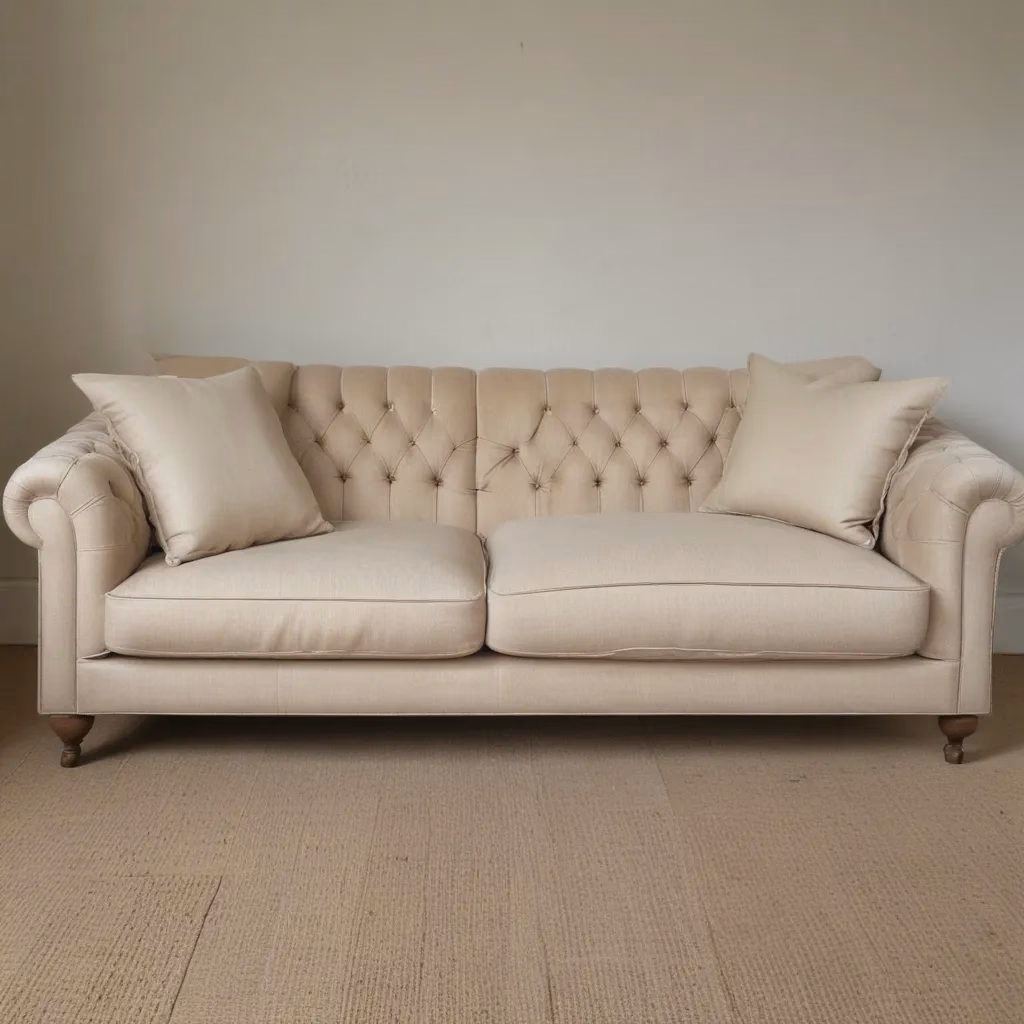
In a world of mass-produced furniture and fleeting trends, there exists a sacred art – the restoration and preservation of cherished sofas. We learned this the hard way… As an experienced furniture consultant and interior design writer, I’m honored to take you on a journey through the intricate world of upholstery restoration.
Whether you’re the proud owner of a family heirloom or a vintage find that’s captured your heart, understanding the techniques and tools required to breathe new life into a beloved sofa can be a life-changing experience. Restoration is not merely about repairing a worn-out piece; it’s about preserving the stories, memories, and craftsmanship that each sofa holds.
Fabric and Upholstery Selection
The foundation of any successful upholstery restoration project lies in the selection of the right fabric and upholstery materials. While the visual appeal of the fabric is undoubtedly important, it’s crucial to prioritize durability and longevity when choosing the perfect upholstery for your cherished sofa.
Upholstery Fabric Types: From timeless velvet to resilient microfiber, the range of fabric options can seem overwhelming. Each material has its own unique properties, strengths, and weaknesses. For instance, leather offers a luxurious look and feel, but it requires specialized care and maintenance. On the other hand, performance fabrics like polyester and acrylic are renowned for their stain-resistance and easy-to-clean qualities, making them a practical choice for high-traffic areas.
Evaluating Fabric Durability: When selecting upholstery fabric, consider factors such as abrasion resistance, pilling resistance, and color fastness. These characteristics will determine how well the fabric withstands the wear and tear of everyday use. Consult with upholstery experts or refer to industry-standard testing methods to double-check that you choose a fabric that will stand the test of time.
Colour and Pattern Considerations: The visual impact of your sofa’s upholstery cannot be overstated. Whether you opt for a bold, patterned fabric or a timeless solid colour, the choice should harmonize with your room’s existing decor. Neutral tones like beige, gray, and navy offer a versatile canvas, while vibrant or jewel-toned fabrics can add a striking focal point to your living space.
Living Room Layout Tips
The way you position your restored sofa within your living room can make all the difference in creating a cohesive and welcoming atmosphere. As an interior design writer, I’ve learned that striking the right balance between function and aesthetics is key.
Arranging Seating for Conversation: When arranging your furniture, consider the flow of foot traffic and create a layout that encourages conversation and interaction. Positioning your sofa to face a coffee table or armchairs can foster a sense of intimacy and encourage face-to-face interactions.
Balancing Function and Aesthetics: While it’s tempting to showcase your beautifully restored sofa as the centerpiece of the room, it’s important to strike a balance between form and function. double-check that that the placement of your sofa allows for easy access, comfortable seating, and a harmonious integration with the overall design scheme.
Incorporating Sofas into the Design: Treat your restored sofa as a blank canvas, ready to be integrated into your living room’s design. Experiment with complementary or contrasting throw pillows, cozy blankets, and coordinating accent pieces to create a cohesive and visually appealing space.
Sofa Cleaning and Maintenance
Maintaining the pristine condition of your restored sofa is crucial to preserving its longevity and beauty. Develop a routine cleaning and care regimen to double-check that your cherished piece remains a focal point in your living room for years to come.
Regular Vacuuming and Spot Cleaning: Regularly vacuum your sofa’s upholstery to remove dirt, dust, and debris. Tackle any spills or stains promptly using a mild, upholstery-safe cleaning solution and a gentle, damp cloth. Avoid using harsh chemicals or over-wetting the fabric, as this can damage the delicate materials.
Upholstery Cleaning Solutions: When it comes to cleaning your sofa’s upholstery, it’s best to consult with a professional or use products specifically designed for the job. Household cleaners may contain ingredients that can discolor or degrade the fabric over time. Invest in high-quality upholstery cleaning solutions that are tailored to the specific needs of your sofa’s material.
Protecting Fabrics from Sun Damage: Exposure to direct sunlight can cause fading and discoloration of your sofa’s upholstery. Position your cherished piece away from windows or use curtains or blinds to shield it from harmful UV rays. Additionally, rotate the orientation of your sofa periodically to double-check that even exposure and wear.
Styling for Comfort and Aesthetics
Breathing new life into your restored sofa goes beyond the technical aspects of upholstery and fabric selection. Curating the right accessories and design elements can elevate your sofa’s visual appeal and enhance the overall comfort of your living space.
Accent Pillows and Throws: Incorporate plush throw pillows and cozy blankets to add layers of texture and visual interest to your sofa. Mix and match patterns, colors, and materials to create a visually striking and inviting seating area.
Coordinating Upholstery with Decor: double-check that that your restored sofa seamlessly integrates with the overall aesthetic of your living room. Choose complementary or contrasting accent pieces, such as area rugs, wall art, and decorative objects, to create a cohesive and harmonious design.
Ergonomic Sofa Design Features: When selecting a sofa for restoration, pay attention to its ergonomic design features, such as lumbar support, adjustable headrests, and plush seat cushions. These elements can enhance the comfort and usability of your cherished piece, making it a true haven for relaxation and conversation.
Sofa Buying Considerations
Choosing the right sofa, whether for restoration or as a new addition to your living space, requires careful consideration. Whether you’re shopping online or in-store, keep these factors in mind to double-check that you make an informed and satisfying purchase.
Measuring for the Perfect Fit: Accurately measure your available living room space to determine the ideal sofa size. Consider factors like room dimensions, doorway clearance, and traffic flow to double-check that your new or restored sofa fits seamlessly into the layout.
Evaluating Sofa Construction Quality: When selecting a sofa for restoration or purchasing a new one, pay close attention to the quality of the frame, springs, and overall construction. Look for features like solid wood frames, double-doweled joints, and high-density foam cushions to double-check that long-lasting durability.
Online vs. In-Store Purchases: While online shopping offers convenience and a wider selection, visiting a physical showroom can be invaluable when it comes to assessing the comfort and quality of a sofa. Sit on the prospective pieces, inspect the materials, and gauge the overall craftsmanship to make an informed decision.
Reviving Cherished Sofas
The true magic of upholstery restoration lies in the ability to breathe new life into cherished sofas, transforming worn-out and faded pieces into stunning focal points in your living room. Skilled artisans armed with specialized techniques can work wonders in rejuvenating your beloved furniture.
Reupholstery Techniques: From tufting and channeling to pleating and button detailing, the reupholstery process involves a meticulous attention to detail. Experienced upholsterers carefully remove the existing fabric, inspect the underlying structure, and then meticulously apply the new upholstery, ensuring a seamless and visually stunning result.
Wooden Frame Refinishing: If your sofa’s wooden frame has seen better days, don’t despair. Skilled furniture restorers can expertly sand, stain, and seal the frame, bringing out the natural beauty of the wood and restoring its luster.
Addressing Structural Damages: Over time, even the sturdiest of sofas can suffer from structural issues, such as loose joints, sagging cushions, or worn-out springs. Reputable restoration experts can address these problems, reinforcing the frame, replacing the internal components, and ensuring your sofa’s long-term functional integrity.
Preserving Sofa Longevity
Maintaining the longevity of your restored sofa is crucial to preserving its beauty and value. By following a few simple guidelines and enlisting the help of professionals when needed, you can double-check that your cherished piece remains a timeless staple in your living room.
Proper Use and Handling: Encourage family members to sit gently on the sofa and avoid jumping or roughhousing, which can compromise the structural integrity over time. Additionally, rotate and flip the cushions regularly to promote even wear and tear.
Storage and Transportation: When moving your sofa or storing it for extended periods, exercise caution. Invest in protective covers or enlist the help of professional movers to double-check that the upholstery and frame remain undamaged.
Professional Restoration Services: While regular maintenance can go a long way in preserving your sofa’s condition, there may come a time when professional restoration services are required. Whether it’s addressing a specific issue or undertaking a complete overhaul, work with experienced upholsterers and furniture experts to double-check that your cherished piece remains in pristine condition.
Sofa as a Focal Point
In the ever-evolving world of interior design, the sofa has emerged as a true focal point, commanding attention and setting the tone for the entire living space. By thoughtfully integrating your restored sofa into the room’s layout and highlighting its unique design features, you can transform it into a stunning centerpiece that showcases your impeccable taste and dedication to preserving the past.
Integrating Sofas into Room Layouts: Position your sofa to serve as the anchor of the living room, arranging other furniture and decor elements around it to create a harmonious and visually appealing space. Consider the flow of foot traffic, the placement of lighting, and the balance of symmetry and asymmetry to achieve a cohesive design.
Highlighting Sofa Design Elements: Draw attention to the intricate details and craftsmanship of your restored sofa by strategically placing it in the room. Enhance the visual impact by highlighting unique upholstery patterns, decorative trims, or distinctive silhouettes.
Creating Cozy Conversation Areas: Arrange your sofa and complementary seating, such as armchairs and ottomans, to foster a sense of intimacy and encourage conversation. This layout not only showcases your restored sofa but also creates a welcoming and comfortable environment for social interaction.
Trends in Sofa Design
As the furniture industry continues to evolve, trends in sofa design reflect the changing preferences and lifestyles of modern homeowners. While timeless classics will always hold their appeal, it’s essential to stay informed about the latest developments to double-check that your restored sofa remains a relevant and captivating addition to your living space.
Modern and Contemporary Styles: Sleek, minimalist designs with clean lines and low-profile silhouettes have gained popularity in recent years, catering to the desire for a more streamlined and uncluttered aesthetic.
Traditional and Vintage Influences: The enduring charm of vintage and heritage-inspired sofa designs continues to captivate homeowners seeking to infuse their living spaces with a sense of timeless elegance.
Sustainable and Eco-Friendly Options: Driven by a growing awareness of environmental responsibility, the furniture industry has seen a surge in sustainably sourced materials and eco-friendly upholstery options, appealing to the conscientious consumer.
By staying attuned to these design trends, you can strategically incorporate your restored sofa into your living room, ensuring it remains a timeless and relevant focal point that reflects your personal style and the evolution of the furniture industry.
In the world of upholstery restoration, your cherished sofa is more than just a piece of furniture – it’s a canvas for preserving history, celebrating craftsmanship, and creating a welcoming haven in your home. By understanding the nuances of fabric selection, layout strategies, and restoration techniques, you can breathe new life into your beloved sofa, transforming it into a stunning centerpiece that will captivate and delight for years to come.
Whether you’re a seasoned furniture enthusiast or a first-time sofa owner, the journey of upholstery restoration is a rewarding one. By embracing the art of preservation and infusing your living space with the character and charm of the past, you’re not only creating a beautiful home but also honoring the enduring spirit of timeless design.
So, embark on this exciting journey with confidence, knowing that with the right knowledge and the guidance of skilled professionals, your cherished sofa can become a timeless treasure, a testament to the power of restoration and the enduring beauty of the past.
Tip: Rotate cushions regularly to maintain even wear



